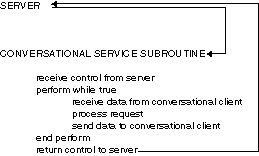


|

|
|
|
|
BEA Tuxedo Servers
A BEA Tuxedo ATMI server is a process that provides one or more services to a client. A service is a specific business task that a client may need to perform. Servers receive requests from clients and dispatch them to the appropriate service subroutines.
Basic Server Operation
To build server processes, applications combine their service subroutines with a main() process provided by the BEA Tuxedo system. This system-supplied main() is a set of predefined functions. It performs server initialization and termination and allocates buffers that can be used to receive and dispatch incoming requests to service routines. All of this processing is transparent to the application.
The following figure summarizes, in pseudo-code, the interaction between a server and a service subroutine.
Pseudo-code for a Request/Response Server and a Service Subroutine
After initialization, an ATMI server allocates a buffer, waits until a request message is delivered to its message queue, dequeues the request, and dispatches it to a service subroutine for processing. If a reply is required, the reply is considered part of request processing. The conversational paradigm is somewhat different from request/response, as illustrated by the pseudo-code in the following figure. Pseudo-code for a Conversational Service Subroutine
The BEA Tuxedo system-supplied main() process contains the code needed to enroll a process as an ATMI server, advertise services, allocate buffers, and dequeue requests. ATMI functions are used in service subroutines that process requests. When you are ready to compile and test your service subroutines, you must link edit them with the server main() and generate an executable server. To do so, run
the buildserver command. Servers as Requesters If a client requests several services, or several iterations of the same service, a subset of the services might be transferred to another server for execution. In this case, the server assumes the role of a client, or requester. Both clients and servers can be requesters; a client, however, can only be a requester. This coding model is easily accomplished using the BEA Tuxedo ATMI functions. Note: A request/response server can also forward a request to another server. In this case, the server does not assume the role of client (requester) because the reply is expected by the original client, not by the server forwarding the request.

|

|
|
|
|
Copyright © 2001 BEA Systems, Inc. All rights reserved.
|